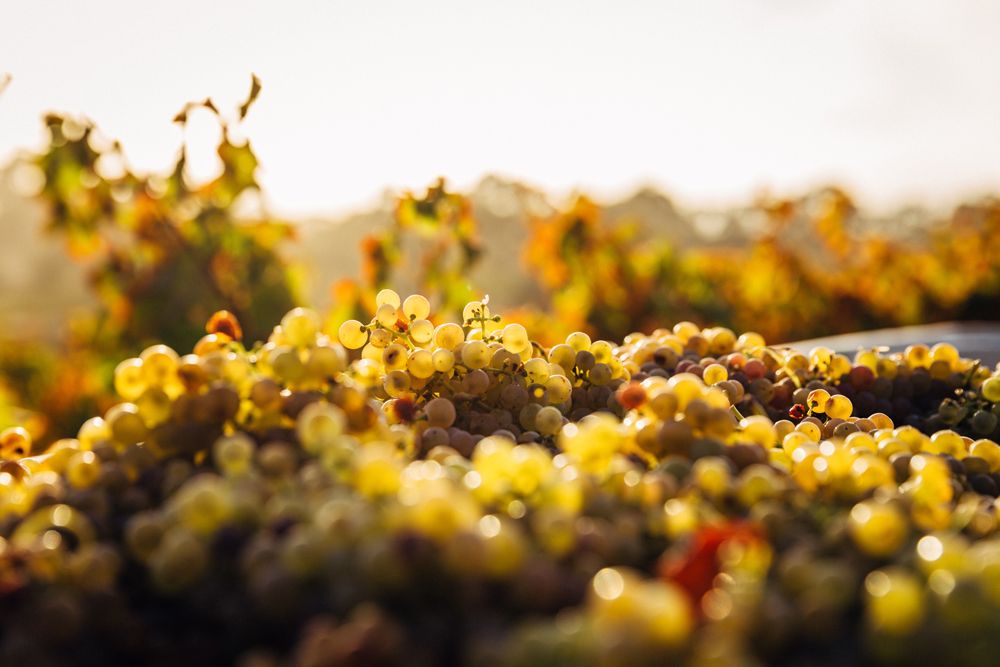
White vinification
The grape harvest
It is the dawn of a radiant day in late September. The warm rays of the sun begin to tickle my opalescent, golden-yellow skin. Among the shiny green leaves, I see my siblings, made plump and bright by a cheery summer and a generous land. We are all full of energy, or rather, sugar, and our aroma spreads all over the hill. I smile at the new day and prepare to welcome the warmth coming up from the east, but a column of humans rises from the slope. In their hands they carry small colourful boxes and sharp scissors. There are worried murmurs among us: some time ago, those same scissors took away whole families, large bunches of grapes from the plant without us understanding why. Thinning they called it. We try to hide under the magnanimous shadow of the leaves, but already the scissors are coming down on the stalks. We are taken off the vine and placed in boxes. The tension is palpable, even if our fear slowly recedes because the hands holding us are delicate and we are comfortable in the boxes, we are not too crushed. I start to relax and drowsiness overcomes me. Now it’s off to the cellar, I hear someone say as I doze off.
White vinification
Once here, the fairy tale of our berry would be in danger of turning red, the atmosphere in the cellar would become gloomy, and let’s be honest, there would be no princess’s kiss to turn the berry into precious juice. Put it this way, even though the grape will no longer be with us in a short while, its soul will remain a protagonist until the end, when it can finally slip into a glass and make someone else’s soul happy.
In reality, the transformation of the berry is a less drastic process than in the past and requires a certain delicacy. Before being pressed, the grapes are kept overnight in cold storage to promote the concentration of primary aromas. In the past, white vinification involved soft crushing and subsequent draining to remove the solid parts of the grapes, but now membrane presses are almost always used. These consist of perforated steel cylinders with a rubber membrane inside which very gently compresses the grapes, allowing the juices to flow out of the holes but preventing the stems and skins from breaking, as they could release pigments and undesirable substances. The juice from the grapes thus obtained is called flower must and, although it has a lower yield, around 60-65%, it is a product that pays off in terms of quality.The must is composed of water (70-80%), sugars in varying amounts – which will be transformed into ethyl alcohol -, acids, polyphenols, minerals, vitamins, pectic and nitrogenous substances and micro-organisms, all of which contribute to the character of the wine.
Once the must has been treated, it goes through alcoholic fermentation, a process during which, thanks to the action of the yeasts, the sugar is transformed into ethyl alcohol, carbon dioxide and thermal energy. For white vinification, fermentation usually takes place in refrigerated double-walled steel fermenters that keep the temperature between 18 and 22° C, ideal for avoiding undesirable oxidation phenomena. In some cases, the must may be fermented in cement tanks, terracotta amphorae, wooden barrels or barriques. In the latter case, at the end of fermentation, the wine is not racked but continues its ageing in wood, while in other cases it is racked into steel containers or sometimes into casks (but there may also be a period in steel and one in wood) where it continues to mature.
For some wines, malolactic fermentation may be carried out before ageing. This is a process carried out by lactic bacteria that transform a molecule of malic acid (the most bitter acid present in the grapes) into one of lactic acid and one of carbon dioxide. The lactic acid is more delicate and sweet and makes the wine softer and more balanced. It also gives more persistence and body to the wine, and its aroma is enriched with hints of vanilla, nuts, butter, toast, spices and leather.
After ageing, before bottling the wine may need a few minor adjustments such as clarification and filtration to avoid cloudiness and disease.
The last stage is bottling, which must be carried out using filling machines equipped with special instruments that introduce inert gases into the bottle before corking to avoid problems of oxidation and browning. Glass remains the best material for storing wine because it does not alter the wine in any way, while the cork can be made of different materials: silicone and synthetic agglomerates are good for wines to be consumed in a short time because they do not allow air exchange with the outside, while cork is the material par excellence for wines that continue to age in the bottle.
Bottling concludes the wine-making process. Now all that remains is to uncork the bottle and savour the soul of that little grape that sacrificed itself for our happiness.




Suecep
[url=https://prednisone2023.online/]cost of prednisone in canada[/url]